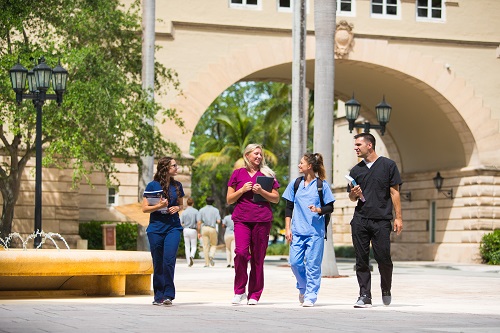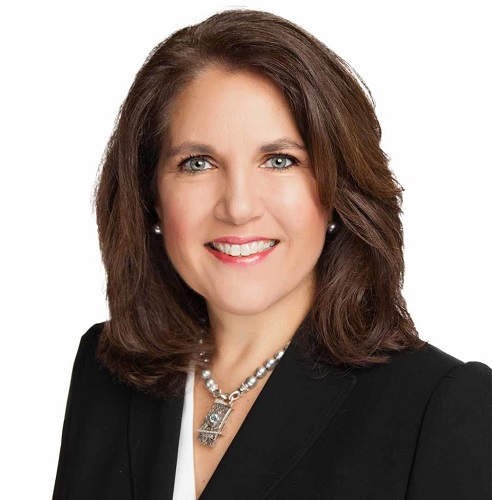Vivian Sanchez, Chancellor of USAHS
By Carol Newman
Using a 3D printer to create a custom assistive device for physical therapy or having students in Miami interact with nursing home residents in New Jersey via telehealth exemplify the mindset that defines rehabilitative health sciences education at the University of St. Augustine for Health Sciences’ (USAHS) Miami campus.
“We leverage the latest technology and emerging trends to prepare students for future success and as leaders of their professions,” says Miami-based Vivian Sanchez, Chancellor of USAHS, a national institution with five campuses including one in Miami. “The future of physical therapy and occupational therapy integrates technology with direct patient care. We want students to appreciate the many ways they can influence patient outcomes.”

Coursework in the Doctor of Physical Therapy program includes designing custom orthotics for the upper extremities. Occupational therapy students use virtual reality to experience their patient’s environment remotely and better understand the person’s challenges. Creating finger gutters for a patient or navigating the patient’s kitchen using the magic of virtual reality, challenges students, in a tangible manner, to explore how they can help their patients.
Sanchez, who oversees campuses in three states, says this culture of innovation sets USAHS apart. Each campus has a state-of-the-art clinical practice simulation center where students are immersed in inpatient and outpatient scenarios using the healthcare technologies of the future. The sim centers, along with community clinical partnerships and pro-bono clinics, provide invaluable experience and expose students to a wide range of patient populations. Students on the Miami campus conduct weekly pro-bono clinics to enhance mobility for Parkinson’s patients. Research by USAHS faculty indicates that interventions to prevent falls doesn’t slow the progression of the disease but it can mitigate some of its debilitating effects and improve a person’s quality of life.
Born and raised in Miami, Sanchez is a product of Georgetown University’s renowned School of Foreign Service and holds an MBA from Harvard. She had a successful career in international finance before turning her sights on higher education.
In 2004, lured by the opportunity to effect positive change in the community she loved, she joined Florida International University (FIU) as Chief Financial Officer & Senior Vice President for Administration. Sanchez played a pivotal role during a transformational time in FIU’s history, including the creation of a medical school. Inspired by the lasting impact of higher education, Sanchez moved on from FIU to serve in various executive leadership roles including overseeing a network of universities across Latin America followed by a global coalition of internationally renowned universities.
Sanchez says her corporate toolkit has served her well for the past 20 years, complementing the valuable skills that academics bring to the table. “They understand what it takes to be a great scholar and I understand what it takes to formulate a strategic vision, implement it effectively and operate efficiently,” she says.
According to Sanchez, viewing students, and in turn their patients, as consumers is a game changer within higher education. “The organizations that sustain themselves are the ones that continue to create value for their consumers and are deeply driven by purpose. Organizations must have clarity of purpose,” she said. Sanchez ensures that USAHS’ purpose is front and center, and that each faculty and staff member is driven by a common goal of developing exceptional clinicians who in turn will transform health care and the communities they serve.
USAHS opened 45 years ago as the Institute for Physical Therapy, the first independent school to confer a graduate degree in physical therapy. Today, the University has campuses in California, Texas, and Florida, where the school is investing over $73 million to relocate the St. Augustine campus this year to a retrofitted historic building.
The Miami campus opened in 2016, and after a multi-million dollar retrofit, is housed at the historic Douglas Entrance in Coral Gables. Under Sanchez’ leadership, enrollment has tripled and campuses in five thriving cities are poised to fill critical workforce gaps in those regions. Becoming the nation’s largest degree-granting institution in graduate rehabilitation programs, USAHS alumni are estimated to be treating more than 500,000 patients each week across 50 states and 21 countries.
“Our national expansion has been purposeful. We look for market gaps that the university can fill and tap into a student body that will evolve into a diverse workforce reflective of the communities they serve,” said Sanchez. “The future of healthcare must include practitioners who reflect the communities that they serve.”


























